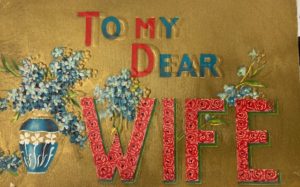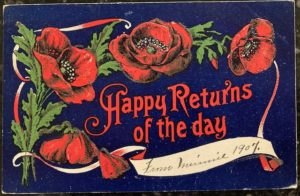 Not a single postcard found in Martha Orr’s keepsake box is written to or from anyone living in Augusta, Georgia or from the cities and towns closest to us. Only one of the over two hundred postcards bears any connection to Georgia and it’s addressed to Mrs. C. G. Orr from her brother Hugh. The postcard shows a beautiful red brick building with a classical Greek inspired portico and stripped canvas awnings. Printed in the top left hand corner is,
Not a single postcard found in Martha Orr’s keepsake box is written to or from anyone living in Augusta, Georgia or from the cities and towns closest to us. Only one of the over two hundred postcards bears any connection to Georgia and it’s addressed to Mrs. C. G. Orr from her brother Hugh. The postcard shows a beautiful red brick building with a classical Greek inspired portico and stripped canvas awnings. Printed in the top left hand corner is,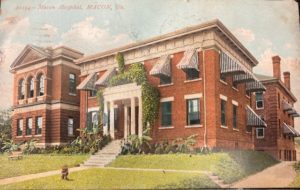 “Macon Hospital, MACON, Ga. Hugh writes to his sister, “I am in fine health at present. Hope you are in the same.” It’s unclear if Hugh is convalescing at the hospital, visiting Macon, or perhaps living there. A deeper dive into Martha Orr’s life reveals her maiden name to be Palliser, and her brother Hugh Palliser, according to the 1910 Census was a travelling salesman for the soup industry. Perhaps Macon, Georgia was on his route.
“Macon Hospital, MACON, Ga. Hugh writes to his sister, “I am in fine health at present. Hope you are in the same.” It’s unclear if Hugh is convalescing at the hospital, visiting Macon, or perhaps living there. A deeper dive into Martha Orr’s life reveals her maiden name to be Palliser, and her brother Hugh Palliser, according to the 1910 Census was a travelling salesman for the soup industry. Perhaps Macon, Georgia was on his route.
Tying the keepsake box and the artifacts found within back to Augusta, Georgia has proven difficult but in doing so we’ve discovered a bit about the life Martha Orr. We are unsure how or why the box came into the possession of the Augusta Public Library, as there is no deed of gift or record of the library receiving it. For years, it sat overlooked on the shelves of the Library’s special collections room until recently when we decided to do a little more digging into its owner, Martha Orr.
If anything, the box and its postcards are a treasure trove of clues into Martha’s life, just waiting to be discovered. In March we celebrate Women’s History Month and for genealogists searching for those elusive female ancestors, this month might be a perfect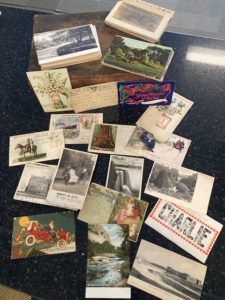 time to give some attention to the women in your family tree. Remember, women make up half of our family trees and their stories deserve to be told.
time to give some attention to the women in your family tree. Remember, women make up half of our family trees and their stories deserve to be told.
Most women, as keepers of the home and family were active letter writers in the nineteenth and early twentieth centuries and historical postcards abound in family collections. Postcards offer a unique window into an ancestor’s world and can provide rich visuals of the places she may have visited or resided, building a realistic picture of her life. In Martha Orr’s case her postcards coupled with census records, city directories, birth, marriage and death records paint detailed picture of a life typical of her time period, one devoted to family and the domestic sphere. While official records like birth, marriage and death certificates can give us dates and locations of major life events, postcards are a time capsule into all the living that occurs in the midst of major life events. Our ancestors are more than just dates and locations, they led rich, meaningful lives. Postcards help us know them on a personal level.
All the postcards in Martha’s collection are addressed to 123 Halsey Street, Brooklyn NY and most to: Mrs. C. G. Orr, though a few are addressed to Charles and Willie Orr, dated in the first decade of the twentieth century. Many are holiday themed, sent to Martha from friends and family during Christmas and Easter, and many depict scenes from the natural world, cityscapes, and historic buildings in places such as Montreal, Canada, Baltimore, Maryland and New Haven, 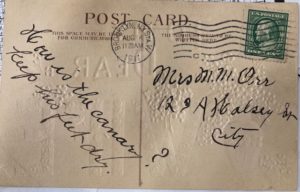 Connecticut. Searching the names on these postcards in census records reveals relationships, showing Martha’s brothers and sisters, seven in total, living in Montreal, Baltimore, and New Haven. Census records also provide us with Martha’s maiden name, Palliser. According to the 1881 Census of Canada, Martha at 20 is the oldest of her siblings, living with their mother and father, Joseph and Jane Palliser in St. Andrews, Quebec, Canada. Sometime between 1881 and 1900 the whole family relocated to 123 Halsey Street and Martha, according to the 1920 U. S. Census is married to Charles Orr, making her Mrs. C. G. Orr. Charles’ occupation is listed as police officer and Martha, dressmaker. Census records corroborate everything found in the postcards, like fitting together puzzle pieces.
Connecticut. Searching the names on these postcards in census records reveals relationships, showing Martha’s brothers and sisters, seven in total, living in Montreal, Baltimore, and New Haven. Census records also provide us with Martha’s maiden name, Palliser. According to the 1881 Census of Canada, Martha at 20 is the oldest of her siblings, living with their mother and father, Joseph and Jane Palliser in St. Andrews, Quebec, Canada. Sometime between 1881 and 1900 the whole family relocated to 123 Halsey Street and Martha, according to the 1920 U. S. Census is married to Charles Orr, making her Mrs. C. G. Orr. Charles’ occupation is listed as police officer and Martha, dressmaker. Census records corroborate everything found in the postcards, like fitting together puzzle pieces.
Using historic postcards to place a female ancestor’s life into a particular time in history is another great way to learn more about her, as she was shaped by the social, political, and economic forces at play. Several of Martha’s postcards depict events going on in the world during her lifetime. For example, Martha’s sister-in-law, Barbara sent a post card in August 1904 showing the icy ruins of a building destroyed in a fire. Barbara writes, “This is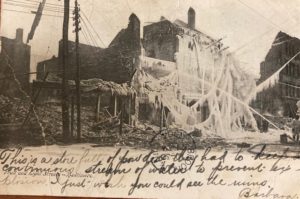 a store full of powder they had to keep a continuous stream of water to prevent an explosion. I just wish you could see the ruins.” Turns out Baltimore, where Barbara and Martha’s brother Robert lived, experienced a great fire in 1904 that was ranked the third worst in U. S. history.
a store full of powder they had to keep a continuous stream of water to prevent an explosion. I just wish you could see the ruins.” Turns out Baltimore, where Barbara and Martha’s brother Robert lived, experienced a great fire in 1904 that was ranked the third worst in U. S. history.
Do you have historic postcards, letters, or other treasures that may hold secrets about the women who’ve gone before you? Take some time in March to find out. As always, staff of the Georgia Heritage Room is here to assist with any and all genealogy questions. Reach out to us by phone 706-826-1511 or email genealogy@arcpls.org.

